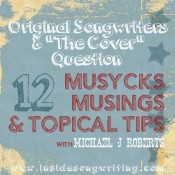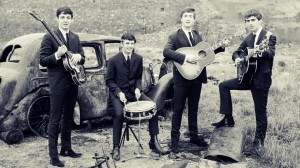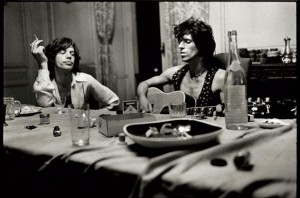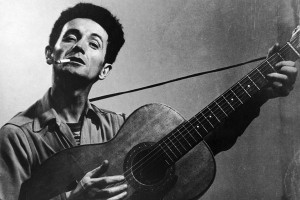Musycks Musings & Topical Tips 12: Original Songwriters and the Cover Question

Original songwriters and the cover question
A weekly column by Inside Songwriting contributor, Michael J Roberts.
All songwriters start out consuming and most likely playing or singing other writers songs, it’s how we learn, through what resonates with us as fans. As a singer-songwriter develops their own catalogue and finds their own voice they will typically reach a point where a repertoire that may have been cover heavy becomes cover light. Some writers are so prolific that they very quickly acquire a live set full of their own material, to the exclusion of any other songs. Is this a good thing?
Cover songs tell us a lot about the artist, little clues into the psyche and taste of the creative mind, and should not be dismissed as a way to fill time in a set. In fact, there are times when it is wise to include a cover song at the expense of an original song, even if you have more than enough good material to warrant an entirely original set.
Of course, singer-songwriters playing live sets almost entirely their own creations is a relatively new thing, so how did we get here?
In the Beginning
Songwriters come to the art of songwriting via many different means, for a multitude of reasons. A quick look at several giants from the start of the modern or rock era of popular song gives us a few salient examples. In the early 1960’s The Beatles were almost exclusively a covers band, making their name by playing ferocious and Preludin fuelled covers of their favourite American R&B acts. John Lennon and Paul McCartney dabbled in creating their own songs but were mostly a little embarrassed to offer them to the band to include in their live set. That changed when the Liverpool impresario Brian Epstein came on board as manager, quickly seeing that original songs offered a point of difference for the band and another commercial opportunity via publishing. He pushed the songwriting duo into producing more songs and including them in their set and it was this dimension that eventually led to the band getting a recording contract with EMI after Ardmore and Beechwood (EMI’s publishing arm) signed them up.
The first two Beatle albums still contained roughly 50% cover songs until their third album; A Hard Day’s Night became the first to contain only Lennon and McCartney songs. The album was something of a game changer, and notwithstanding that Beatles For Sale, their next album contained several covers, it was soon the case that Beatle albums were solely original, setting the benchmark for artists everywhere. The Beatles, who had always included covers in their live set because of their love of the music, never again played live after 1966 to a concert audience.
It’s informative to see what songs attracted the bands attention to the point they would cover them, great rhythmic and melodic confections from across the Atlantic from teams like Goffin and King, or black writers like Arthur Alexander. A quick listen to either of the excellent Live At The BBC albums will soon reveal a lot about the influences the band embraced. It’s telling that both Paul and John, when they put touring or live bands together in the 1970’s both included cover songs of writers they loved, typically the music of their youth.
And It Stoned Me
The Yin to the Beatle’s Yang, The Rolling Stones, were exclusively a covers band too when they started playing around the clubs and pubs of London in the early 1960’s. On the back of the Beatles success the Stones soon became a hit recording act with a problem. They prided themselves on finding choice American R&B cuts, songs by Howling Wolf, Elmore James, Muddy Waters or Little Walter but it soon became apparent that the source was not infinite and only so many variations of that rough 12 bar form that could be commercially sustained. Their savvy manager Andrew Loog Oldham looked at what had happened with the Northern band and promptly marketed his band as the ugly and rough version of The Beatles and then arranged for John and Paul to write a song for The Stones.
John and Paul met The Stones and agreed on an unfinished song called I Want To Be Your Man, which the pair then completed as an amazed Mick Jagger and Keith Richards looked on. The song became a chart hit for The Stones and Oldham, knowing the well was running dry for material, literally locked Jagger and Richard in a kitchen and told them to start writing songs, they came out with the gorgeous As Tears Go By, a subsequent hit for the very young Marianne Faithful. Mick and Keith soon became as prolific as their more famous rivals and wrote dozens of hit songs over the years.
For a band that had one original song on their first album, and one throwaway instrumental, Mick and Keith grew to be the most successful British songwriting team outside of…. Well, you know who. The band still plays mostly original material in live shows, but many albums have contained choice cover songs, like Motown’s Ain’t Too Proud to Beg off It’s Only Rock and Roll, or Harlem Shuffle off Dirty Work. Mick and Keith proved adept at blending many influences, blues, soul, rock and country-soul to provide a massive and enduring body of work. Who knew?
Ramblin’ Woody Dylan
Across the other side of the Atlantic Robert Zimmerman rolled into Greenwich Village in the early ‘60s, intent on finding a niche for himself as a performer of other people’s songs. A failed rock and roll piano player who was invigorated and inspired by Elvis and Little Richard, in the same way the lads from Liverpool were, Bob had discovered American folk music, particularly the songs of Woody Guthrie, and set out to New York to meet the man, play his songs and see what might happen. Zimmerman invented a new name for himself, Bob Dylan, and a fake history to accompany it, telling people he was from New Mexico and had been riding the rails as a hobo like his hero did.
Dylan may have been embarrassed that his “Jewish boy from the Minnesota suburbs’ past was not cool enough for the cognoscenti of New York, but his style and ferocious attack on the hitherto polite world of folk shook the place to the core. What Dylan did not expect was there were people in the Village still writing great songs, he’d assumed that all the great songs had been written and he merely needed to find and sing them in his own style. Bob was gob-smacked that a performer like Rambling Jack Elliot could write songs as good as Woody, and so decided he would write songs as well. What he could not have known was that he’d do it so brilliantly it would change the course of modern music.
Bob took the common Greenwich Village approach at first, that of writing new lyrics over ancient folk tunes, and several of his early hits like Blowin’ In The Wind and Don’t Think Twice it’s Alright are old folk tunes that Bob adapted without credit. Most probably this lack of proper credit was driven by his publishing company, not from Dylan hoping to not be discovered as a plagiarist. The tunes were too well known to get away with any subterfuge.
Soon the Lennon-McCartney effect took hold and it became essential for an artist to write their own songs completely, words and music, in order to be credible. Dylan was obviously heading in that direction anyway, but after 1964 he would never again adapt an old tune and not credit the fact. The astonishing creative outburst Bob enjoyed n the ‘60s led to him becoming the single most important American songwriter of the late 20th century, and one of the greatest of all time. And all this from a guy who thought all the good songs had been written!
Cover Art in the new Millennium
The fallout from the 1960’s singer-songwriter revolution spawned a pre-Cambrian like flourishing in the 1970’s and ever since it has been de rigueur for any band or solo act who aspires to authenticity to provide their own material. So what place for the cover version in a swamped market where audiences now have access to material in so many different ways, inestimably bigger than at any time in the history of the industry?
It would be a mistake to assume playing a cover in a live set is a sell out or a cop out because you write your own songs, even if you have more than enough. The benefit of dropping in the right cover song at the right time in a live set means you are showing your audience another dimension of your art. Part of being a convincing performer and being able to relate to your audience is to provide them with a satisfying live experience. To curate that experience and to even subliminally convince an audience that they are in good hands a judicious cover version can work wonders. Picking the right song and even making it your own by changing it up in a creative way is a fantastic ploy in setting the artistic parameters of your own art, of indicating to your audience something new.
So, don’t shy away from throwing in a great cover song at the right time, or even recording one if the situation and conditions are right to do so. This may seem counter intuitive to the original writer-performer but even losing the songwriting royalties involved is no great sin if the benefits outweigh the negatives. Some performers have even kick-started their careers by doing something creative with a cover song, so as always it’s best to keep an open mind.
Happy songwriting and happy covering!
Musycks
RELATED POSTS / LINKS:
Musycks Musings & Topical Tips Home





